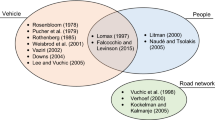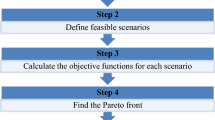Abstract
Coupling analysis of passenger and train flows is an important approach in evaluating and optimizing the operation efficiency of large-scale urban rail transit (URT) systems. This study proposes a passenger—train interaction simulation approach to determine the coupling relationship between passenger and train flows. On the bases of time-varying origin—destination demand, train timetable, and network topology, the proposed approach can restore passenger behaviors in URT systems. Upstream priority, queuing process with first-in-first-serve principle, and capacity constraints are considered in the proposed simulation mechanism. This approach can also obtain each passenger’s complete travel chain, which can be used to analyze (including but not limited to) various indicators discussed in this research to effectively support train schedule optimization and capacity evaluation for urban rail managers. Lastly, the proposed model and its potential application are demonstrated via numerical experiments using real-world data from the Beijing URT system (i.e., rail network with the world’s highest passenger ridership).
Similar content being viewed by others
References
Barrena E, Canca D, Coelho L C, Laporte G (2014). Exact formulations and algorithm for the train timetabling problem with dynamic demand. Computers & Operations Research, 44: 66–74
Cepeda M, Cominetti R, Florian M (2006). A frequency-based assignment model for congested transit networks with strict capacity constraints: Characterization and computation of equilibria. Transportation Research Part B: Methodological, 40(6): 437–159
Cheng Y, Yin J, Yang L (2021). Robust energy-efficient train speed profile optimization in a scenario-based position-time-speed network. Frontiers of Engineering Management, 8(4): 595–614
Cominetti R, Correa J (2001). Common-lines and passenger assignment in congested transit networks. Transportation Science, 35(3): 250–267
Ding L Y, Guo S Y (2015). Study on big data-based behavior modification in metro construction. Frontiers of Engineering Management, 2(2): 131–136
Ding L Y, Xu J (2017). A review of metro construction in China: Organization, market, cost, safety and schedule. Frontiers of Engineering Management, 4(1): 4–19
Fu Q, Liu R, Hess S (2012). A review on transit assignment modelling approaches to congested networks: A new perspective. Procedia: Social and Behavioral Sciences, 54: 1145–1155
Gao Z Y, Yang L X (2019). Energy-saving operation approaches for urban rail transit systems. Frontiers of Engineering Management, 6(2): 139–151
Han B, Zhou W, Li D, Yin H (2015). Dynamic schedule-based assignment model for urban rail transit network with capacity constraints. The Scientific World Journal, 2015: 940815
Ingvardson J B, Nielsen O A, Raveau S, Nielsen B F (2018). Passenger arrival and waiting time distributions dependent on train service frequency and station characteristics: A smart card data analysis. Transportation Research Part C: Emerging Technologies, 90: 292–306
Jamili A, Pourseyed Aghaee M (2015). Robust stop-skipping patterns in urban railway operations under traffic alteration situation. Transportation Research Part C: Emerging Technologies, 61: 63–74
Jiang Z B, Li F, Xu R H, Gao P (2012). A simulation model for estimating train and passenger delays in large-scale rail transit networks. Journal of Central South University, 19(12): 3603–3613
Li W, Zhu W (2016). A dynamic simulation model of passenger flow distribution on schedule-based rail transit networks with train delays. Journal of Traffic and Transportation Engineering, 3(4): 364–373
Li Z, Lo S M, Ma J, Luo X W (2020). A study on passengers’ alighting and boarding process at metro platform by computer simulation. Transportation Research Part A: Policy and Practice, 132:840–854
Liu X B, Huang M H, Qu H Z, Chien S (2018). Minimizing metro transfer waiting time with AFCS data using simulated annealing with parallel computing. Journal of Advanced Transportation, 2018: 4218625
Ma Z L, Koutsopoulos H N (2019). Optimal design of promotion based demand management strategies in urban rail systems. Transportation Research Part C: Emerging Technologies, 109: 155–173
Nökel K, Wekeck R (2009). Boarding and alighting in frequency-based transit assignment. Transportation Research Record: Journal of the Transportation Research Board, 2111(1): 60–67
Nuzzolo A, Crisalli U, Rosati L (2012). A schedule-based assignment model with explicit capacity constraints for congested transit networks. Transportation Research Part C: Emerging Technologies, 20(1): 16–33
Paulsen M, Rasmussen T K, Nielsen O A (2021). Impacts of real-time information levels in public transport: A large-scale case study using an adaptive passenger path choice model. Transportation Research Part A: Policy and Practice, 148: 155–182
Poulhès A (2020). Dynamic assignment model of trains and users on a congested urban-rail line. Journal of Rail Transport Planning & Management, 14: 100178
Schmöcker J D, Fonzone A, Shimamoto H, Kurauchi F, Bell M G H (2011). Frequency-based transit assignment considering seat capacities. Transportation Research Part B: Methodological, 45(2): 392–408
Seriani S, Fernandez R (2015). Pedestrian traffic management of boarding and alighting in metro stations. Transportation Research Part C: Emerging Technologies, 53: 76–92
Shi J G, Yang L X, Yang J, Zhou F, Gao Z Y (2019). Cooperative passenger flow control in an oversaturated metro network with operational risk thresholds. Transportation Research Part C: Emerging Technologies, 107: 301–336
Teng J, Liu W R (2015). Development of a behavior-based passenger flow assignment model for urban rail transit in section interruption circumstance. Urban Rail Transit, 1(1): 35–46
Wang Y H, Tang T, Ning B, van den Boom T J J, de Schutter B (2015). Passenger-demands-oriented train scheduling for an urban rail transit network. Transportation Research Part C: Emerging Technologies, 60: 1–23
Wu J J, Liu M H, Sun H J, Li T F, Gao Z Y, Wang D Z W (2015). Equity-based timetable synchronization optimization in urban subway network. Transportation Research Part C: Emerging Technologies, 51: 1–18
Wu J J, Qu Y C, Sun H J, Yin H D, Yan X Y, Zhao J D (2019). Data-driven model for passenger route choice in urban metro network. Physica A, 524: 787–798
Xie J, Wong S, Zhan S, Lo S, Chen A (2020). Train schedule optimization based on schedule-based stochastic passenger assignment. Transportation Research Part E: Logistics and Transportation Review, 136: 101882
Xu G, Zhao S, Shi F, Zhang F (2017). Cell transmission model of dynamic assignment for urban rail transit networks. PLoS One, 12(11): e0188874
Xu X M, Li C, Xu Z (2021). Train timetabling with stop-skipping, passenger flow, and platform choice considerations. Transportation Research Part B: Methodological, 150: 52–74
Yang J F, Jin J G, Wu J J, Jiang X (2017). Optimizing passenger flow control and bus-bridging service for commuting metro lines. Computer-Aided Civil and Infrastructure Engineering, 32(6): 458–473
Yang W W (2014). Study of sustainable urban rail transit development model in China. Frontiers of Engineering Management, 1(2): 195–201
Yang X, Wu J J, Sun H J, Gao Z Y, Yin H D, Qu Y C (2019). Performance improvement of energy consumption, passenger time and robustness in metro systems: A multi-objective timetable optimization approach. Computers & Industrial Engineering, 137: 106076
Yin H D, Han B M, Li D W, Lu F (2011). Modeling and application of urban rail transit network for path finding problem. In: Proceedings of the 6th International Conference on Intelligent Systems and Knowledge Engineering — Practical Applications of Intelligent Systems. Shanghai: IEEE, 689–695
Yin J T, Wang Y H, Tang T, Xun J, Su S (2017). Metro train rescheduling by adding backup trains under disrupted scenarios. Frontiers of Engineering Management, 4(4): 418–427
Zhang Q, Han B M (2010). Modeling and simulation of transfer performance in Beijing metro stations. In: 8th IEEE International Conference on Control and Automation. Xiamen, 1888–1891
Zhang T Y, Li D W, Qiao Y (2018). Comprehensive optimization of urban rail transit timetable by minimizing total travel times under time-dependent passenger demand and congested conditions. Applied Mathematical Modelling, 58: 421–446
Zhao J J, Qu Q, Zhang F, Xu C Z, Liu S Y (2017). Spatio—temporal analysis of passenger travel patterns in massive smart card data. IEEE Transactions on Intelligent Transportation Systems, 18(11): 3135–3146
Zhu Y, Koutsopoulos H N, Wilson N (2017). A probabilistic passenger-to-train assignment model based on automated data. Transportation Research Part B: Methodological, 104: 522–542
Author information
Authors and Affiliations
Corresponding author
Additional information
This research was supported by the National Key R&D Program of China (Grant No. 2020YFB1600702), the National Natural Science Foundation of China (Grant Nos. 71621001, 72071015, 71701013, and 71890972/71890970), the Beijing Municipal Natural Science Foundation (Grant No. L191024), the 111 Project (Grant No. B20071), and the State Key Laboratory of Rail Traffic Control and Safety (Grant No. RCS2021ZZ001).
Rights and permissions
About this article
Cite this article
Zhang, P., Yang, X., Wu, J. et al. Coupling analysis of passenger and train flows for a large-scale urban rail transit system. Front. Eng. Manag. 10, 250–261 (2023). https://doi.org/10.1007/s42524-021-0180-2
Received:
Accepted:
Published:
Issue Date:
DOI: https://doi.org/10.1007/s42524-021-0180-2




